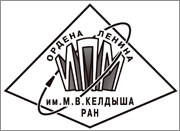|
|
Preprints of the Keldysh Institute of Applied Mathematics, 2010, 036, 24 pp.
(Mi ipmp221)
|
 |
|
 |
Navigation and control during low-thrust transfer from Earth to Jupiter
E. L. Akim, V. A. Stepaniants, A. G. Tuchin, V. V. Sazonov
Abstract:
We consider the interplanetary flight of a spacecraft with low-thrust engines (LTE) from Earth to Jupiter. The flight purpose is landing in Europa. We limit ourself to the long-term part of the trajectory including both LTE operating arcs and coasting arcs. The problem is to determine the spacecraft state vector and LTE parameters (direction and magnitude of the thrust) basing on Russian ground-based radar observations and onboard acceleration measurements. Radar observations include range, range rate, and 3-way Doppler measurements. Solving navigation problems, we take into account both errors in the measurement data and errors in the LTE operation. The last-named errors are presented as a sum of systematic and random components. The systematic components are approximated by linear functions of time in the interval of their correlation. The coefficients of the functions are determined jointly the spacecraft state vector by radar and acceleration measurements. Using the described model, we investigate how the errors in estimating and predicting the spacecraft motion depend on the following factors: the length of correlation intervals of systematic errors, the ratio of systematic and random error components, and from the frequency of determination of the motion fulfillment. We estimate the addition fuel expense to compensate thrust operation errors. The navigation errors can be significantly reduced if the accuracy of onboard accelerometer is better than $10^{-7}$ m/s$^2$
Citation:
E. L. Akim, V. A. Stepaniants, A. G. Tuchin, V. V. Sazonov, “Navigation and control during low-thrust transfer from Earth to Jupiter”, Keldysh Institute preprints, 2010, 036, 24 pp.
Linking options:
https://www.mathnet.ru/eng/ipmp221 https://www.mathnet.ru/eng/ipmp/y2010/p36
|

| Statistics & downloads: |
| Abstract page: | 130 | | Full-text PDF : | 62 | | References: | 25 |
|




 Contact us:
Contact us: Terms of Use
Terms of Use
 Registration to the website
Registration to the website Logotypes
Logotypes








 Citation in format
Citation in format 